Hematite (The Bloodstone Ore) - Mineral Properties and Occurence
Hematite is the abundant form of iron oxide, natural red pigment, and an integral part of the largest iron ore deposits on Earth. Highly aesthetic crystals and shiny botryoidal hematite aggregates are also very popular collector specimens.
The nomenclature of hematite traces its origin to about 300-325 BCE when the Greek, Theophrastus, named it haime as bloodstone. Pliny the Elder, in 79 AD, translated the word into its Latinate form, haematites, for bloodlike, a reference to the brilliant red color of the powder. (This may be the first recorded instance of a mineral name acquiring the suffix -ite.)
In the 15th century, the name evolved from the Latin Lapis Haematites to hematite pierre in Middle French, and from there was adopted in English as hematite, without the a often found in words rooted in haeme. Both variants (haematite/hematite) survive in current use today.
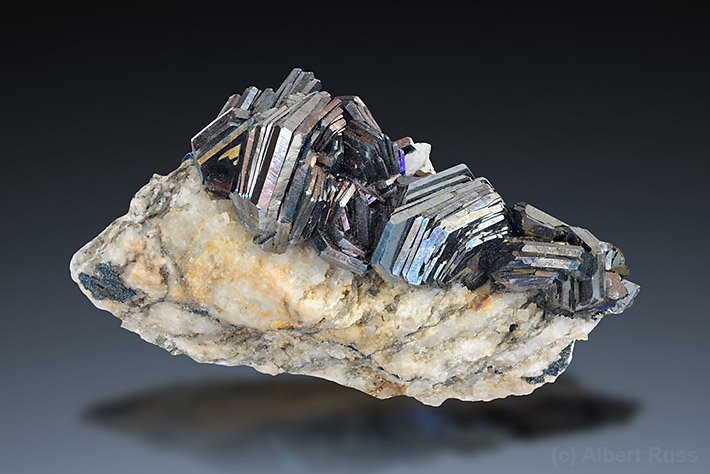
Hematite can easily be rendered into a deep red powder and pigment, and the earliest recorded human use of it dates to pre-Paleolithic times, as early as 164,000 years ago. Graveyards dated at 80,000 years BP also contain hematite residues. Neolithic mines in central Europe circa 5,000 BCE show production of red hematite chalk, as do pre-Roman Etruscan mines in Italy.
The discovery and smelting of iron around 2,500 BCE ushered in the Iron Age in human culture, enabling the production of tools and weapons which offered durability and permanence, materially improving the circumstances of life in the late Neolithic.
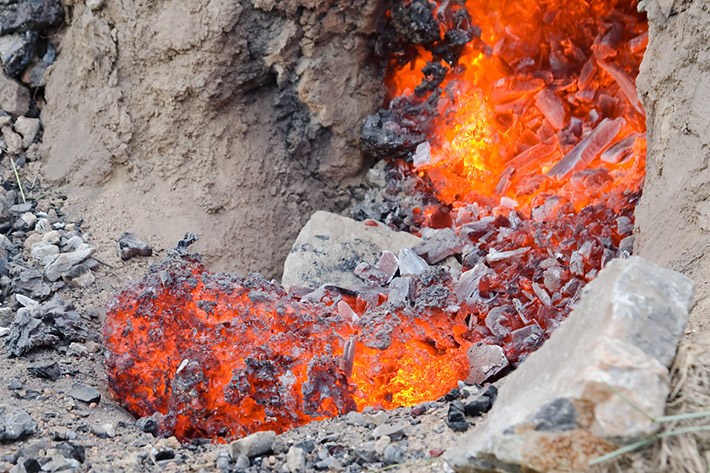
Iron ore is an aggregate of several iron minerals, the main ones being hematite and magnetite. Iron ore and coal were and remain two key components of the Industrial Revolution, since the modern world depends on the mining and refining of iron ore for the integrity of its physical infrastructure: materials for construction, transportation and tools.
Iron mining has survived as a fundamental enterprise, in spite of a marked decrease in ore grade and quality. Its survival is a tribute to the resourcefulness of one individual, who recognized that hematite, a lesser constituent of the raw ore, could be the foundation for continued industrial iron production.
Crystal Structure of Hematite
Hematite formula is Fe2O3, is a simple iron III oxide. Hematite is a member of the trigonal crystal system, exhibiting a large variety of forms. As discrete forms, hematite may occur as small plates or thin splinters. As larger masses, it may be botryoidal, mammilary, reniform, oolitic, radiating, stalactitic, or simply massive. As well-shaped crystals, it may present as scalenohedral, rhombohedral or tabular crystals. Rarely, dendrites and rosettes are recognized. On occasion, it will form a pseudomorph after octahedral crystals of magnetite.
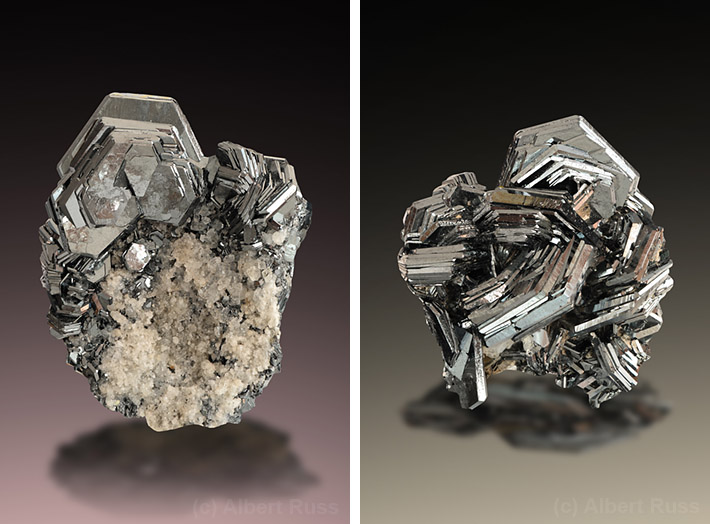
Hematite shares the same crystal structure with ilmenite (FeTiO3), and corundum (Al2O3). Hematite forms a solid solution series with ilmenite (known as titanohematite, hematite-ilmenite or HISS) at high temperatures.
Associated Minerals
A discussion of hematite would not be complete without mentioning its frequent companions, limonite (rock composed of various iron oxides and hydro-oxides) and goethite (α-FeOOH). They are mixtures of hydrated, oxidized Fe2+ and Fe3+ minerals which form as an alteration product of hematite and magnetite, and often record a significant history of both hydrothermal alteration and weathering in mineralized environments.
A great deal of effort in the geologic community has gone into unraveling the complicated history of iron-enriched soils and rocks. That history can be greatly complicated when the weathering occurs in hot, tropical environments and abundant rainfall leaches many elements out of the soil, leaving a thick residue of iron-enriched cap rock containing an admixture of limonite and goethite.

Physical Properties of Hematite
The color of hematite ranges from black to blackish red to silver-gray, to reddish-gray to brown to red. It is metallically lustrous, with a hardness (6.5) greater than iron but with fracture behavior more brittle. Hematite streak is deep red, regardless of its look or color, which is important for identification. Lepidocrocite (γ-FeOOH) ca produce a similar streak, but is much softer (4.5-5.0), and rarely occurs as macroscopic mineral specimens. Goethite is softer (5-5.5) and has yellow or brown streak. The molecular weight of hematite is dominated by iron: Fe 69.94 %; O 30.06 %.
Magnetism
Hematite is weakly magnetic in a peculiar way. In general, the Fe atoms in hematite almost line up their magnetism in a truly alternate pattern, such that the positive and negative magnetic attractions would cancel each other out. However, the atoms aren't quite lined up, so that the atoms collectively form what's called a ferromagnet - an object where the magnetism of atoms is collectively additive and, therefore, can respond to an external magnetic force. Thus, an item of hematite jewelry could probably be picked up by a conventional magnet.
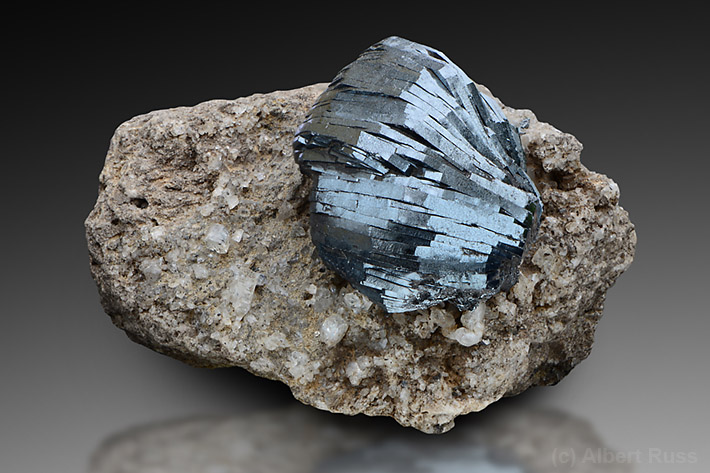
When heated, however, the Fe atoms in hematite point in all directions randomly, and lose their collective additive power. In non-technical terms, hematite possesses soft magnetism: its magnetic domains lose their integrity if the external magnetic force is removed. There are cases where impurities (like Ti) are observed empirically to enhance the magnetic power, but jewelry sold as magnetic hematite is an artificially created material.
Origin of Hematite
Hematite is one of the most ubiquitous minerals on the planet, and the overwhelming majority of it occurs in banded iron formations (BIF) dating from Earth's earliest history in the Precambrian (pre-600 million years ago). Banded iron formations are horizontally-stratified thin-bedded deposits of oxidized (hematite) and reduced (magnetite) deposited cyclically in ancient oceans, alternating with parallel bands of silica (chert).
These accumulations covered vast areas of the Earth, and survive today as extensive outcrop areas in the best-preserved cratons (old shield areas). The top five producers (China, Australia, Brazil, India, Russia) account for 2.6 billion of the 3.0 billion tons of iron ore mined annually.
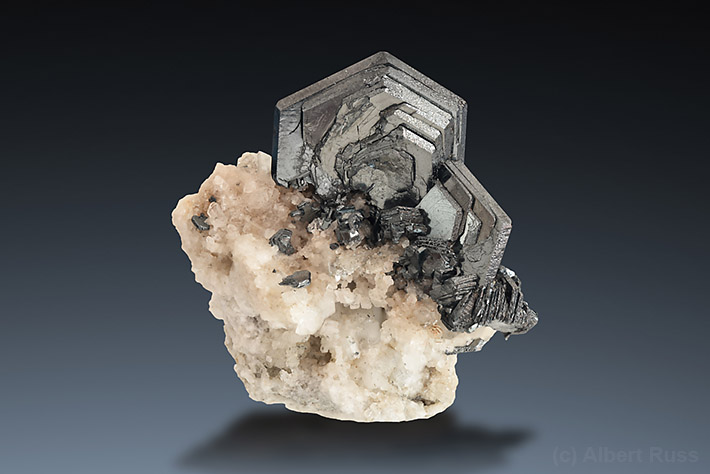
Banded Iron Formation (BIF)
Banded iron formations (BIF) appear to span the period 2.6 to 1.8 billion years ago, with several short periods of intense iron deposition separated by long intervals of no remarkable accumulations. Several clues point to possible explanations. The rapid appearance of BIF followed by extended quiescence implies strong variations in the quantity of atmospheric oxygen, available iron, or both. Iron does not dissolve in the presence of oxygen, implying that Precambrian oceans were oxygen-poor during periods of non-deposition of BIF.
Today, only the deepest portions of isolated seas (i.e. the Black Sea) are euxinic (oxygen-starved). The modern atmospheric oxygen level adequately ventilates the world ocean and sequesters the iron eroding from land, preventing its accumulation and precipitation on the sea floor. However, there is a plausible explanation for the recurring appearance of BIF.
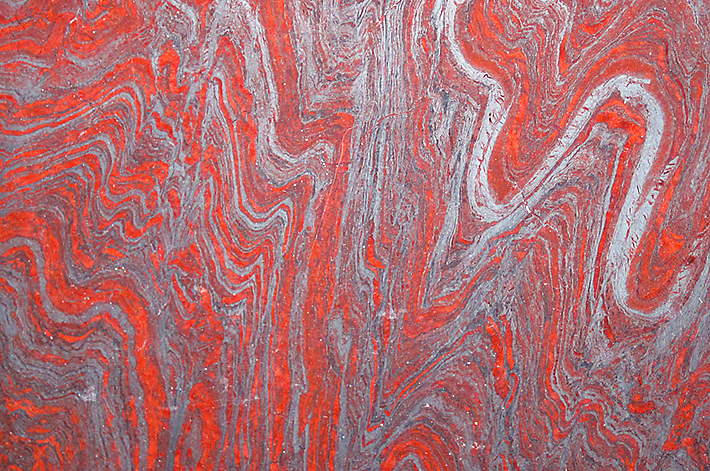
The premise of this theory is that Precambrian waters were fundamentally euxinic (without oxygen), and contained abundant dissolved iron. From time to time, nutrient-rich bottom waters rose to the surface, and available sunlight stimulated an algal bloom in surface waters. A transient increase in biomass exhausted the nutrients, and excreted oxygen drove atmospheric levels higher.
Shallow seawater became supersaturated in iron and allowed its precipitation, while the algae died and sank to the bottom. Their decay consumed the available oxygen faster than it could be replaced from the atmosphere. The oxygen-poor bottom conditions then stimulated another bloom of sulfate-reducing bacteria, whose excretions in life raised atmospheric oxygen levels and whose death further reduced available oxygenated water, setting the stage for endless cycles of upwelling of dissolved iron and its reprecipitation from surface-enriched oxygen.
The explanation for the banded character of BIF arises from the observation that modern episodes of algal blooms are due to seasonal ocean currents. Such blooms occurring in a sea containing dissolved iron would result in a wave of iron precipitation every time atmospheric oxygen levels spiked from photosynthetically generated excretions. Meanwhile, the precipitation of silica would occur as a persistent steady rain.
Bear in mind that, in that era, silica was not yet being incorporated in marine animal shells, so the concentration of silica from continental erosion likely exceeded the oceanic solubility limit of 14-20 ppm. The result is a banded sequence of sediments, where the iron precipitation periodically overwhelmed the gentle accumulation of white silica.
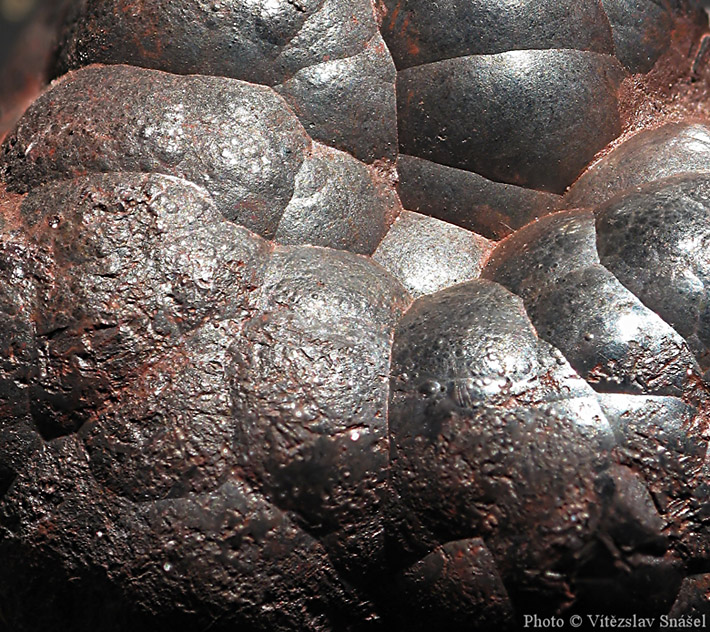
Conventional Settings
Hematite occurs as a primary mineral in many other settings. It can occur as an accessory mineral in near-surface hot springs; as sublimates from volcanic emanations; as vein material in shallow uranium and fluorite mineral systems; and as magmatic segregations in slowly cooling layered intrusions. Hematite is also present in various sediments.
More recently, it has been found in a newly recognized class of giant porphyry deposits called IOCG deposits (iron oxide-copper-gold). These were first discovered at Roxby Downs in Australia about 30 years ago, and explorationists have since targeted them successfully on other continents.
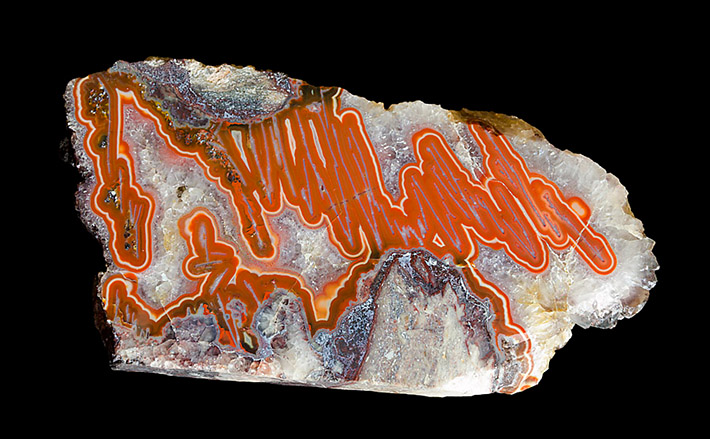
Applications
At this point, it is appropriate to consider hematite in its two distinct incarnations - as a mineral specimen, and as an industrial product.
The Specimen
As a mineral specimen, hematite has limited importance. Collectors appreciate well-formed hematite crystals and aesthetic botryoidal aggregates. Tumbled specimens of lustrous hematite from Brazil are inexpensive, popular specimens.
Hematite has a checkered history as a gemstone. Victorian England probably made the most use of hematite in the last half of the 19th century, using it in a variety of jewelry, such as beads, necklaces and carved ornamental figures.
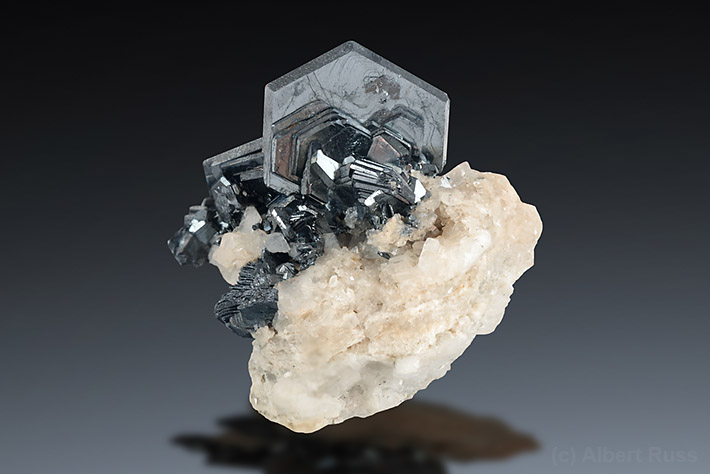
The pigment use of hematite has been self-evident for thousands of years, but has been largely displaced by cheaper substitutes.
The Industrial Product - Taconite
The industrial importance of hematite cannot be overemphasized. The worldwide mining of BIF in the 19th and 20th centuries involved recovering a relatively high quality of ore. With the gradual decline in ore grades, chemists realized that some tweaking of the raw ore might turn unprofitable mine projects into viable survivors. The ore available at the time was taconite, a low-grade variety of iron ore that had been regarded as waste rock since its discovery in 1870.
Chemists recognized the need to upgrade the tenor of ore. The solution implemented was to grind the ore into a fine powder, separate the magnetite with strong magnets, add a binder such as bentonite, and roll the product into 1 cm pellets. The pelletizing process itself is solely credited to E. W. Davis, the Director of the University of Minnesota Mines Experiment Station from 1913 through 1946.
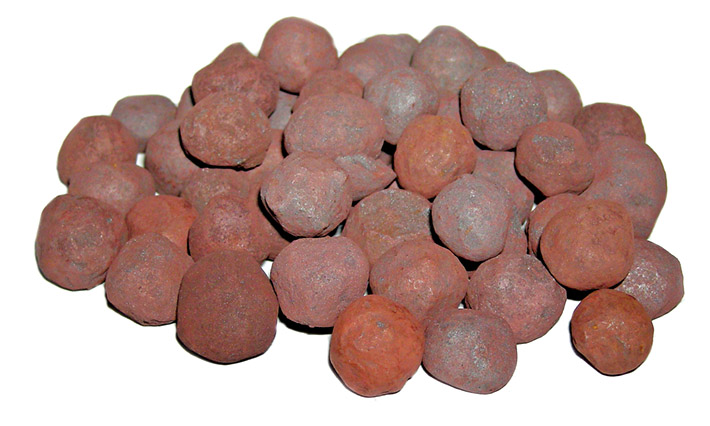
The critical next step was to use a high-temperature furnace to fire the pellets in an exothermic reaction, oxidizing the magnetite (Fe3O4) to hematite (Fe2O3) and reducing the cost of the pelletizing. Thus, what was a low-grade magnetite-dominant ore became an economically viable, industrially produced version of hematite still called taconite, although its composition and grade is significantly different from the source material. Taconite in the commercial sense is the refined product produced from most BIF mines, and shipped worldwide by rail and ship, and fed into blast furnaces for steel production.
Occurrence
Brazil
Brazil's Minas Gerais mineral province is well-known for the quality and abundance of its specimens. Crystals are often described as large and thick, particularly at Itabira, Jaguaracu, Antonio Pereira and Congonhas de Campo. Novo Horizonte and Brumado in the Bahia area supply flat or tabular crystals. Many of these mines provide superb specimens of epitactic growths of hematite and yellow rutile. Minas Gerais typically provides most of the tumbled and polished specimens on the collections market. Some of the tumbled hematites are artificially made of crushed hematite and/or magnetite. Natural hematite is NOT magnetic!
Europe
The Cumberland area of England (Cumbria District) is the home of high-quality specularite, globular and stalactitic specimens. The Rio Marina area on the Mediterranean island of Elba has produced rich deposits of hematite since Etruscan times (ca 700 BCE). Another European locality for large, tabular crystals (Iron Roses)is the Cavradi Gorge area in Grischun, Switzerland. Many other localities in the Alps produce Iron Roses too. Great specularites came from metasomatic deposits with siderite and ankerite in Slovakia.
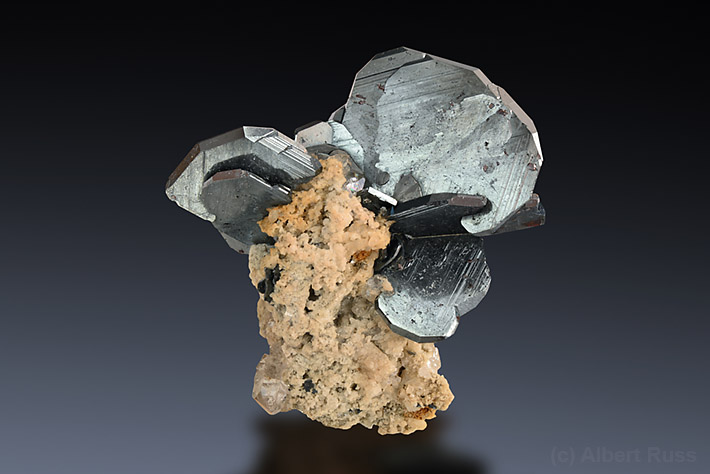
Africa
In North Africa, Morocco has recently yielded collectible hematite from Nodor Province. Nice botryoidal hematites were found in the Irhoud Mine, Safi Province , Morocco. In South Africa, the Kalahari manganese fields produce rarely seen and superb quality prismatic specimens. Nice hematite crystals were found in Ambositra District, Fianarantsoa Province, Madagascar.
North America
The U.S. is the home of a wide variety of occurrences, ranging from a surfeit of specimens from the western area of Lake Superior (the Iron Ranges of Minnesota and Michigan), to numerous localities in Arizona (Aztec Peak, Gila County; Bouse in Yuma County; and the Buckskin Mountains in La Paz County). The principal Great Basin occurrence is the famous Iron Roses in the Thomas Range of Utah. The main East Coast occurrence is at Chub Lake, New York. Great amethyst specimens with hematite were found in Diamond Willow Mine, Ontario, Canada.
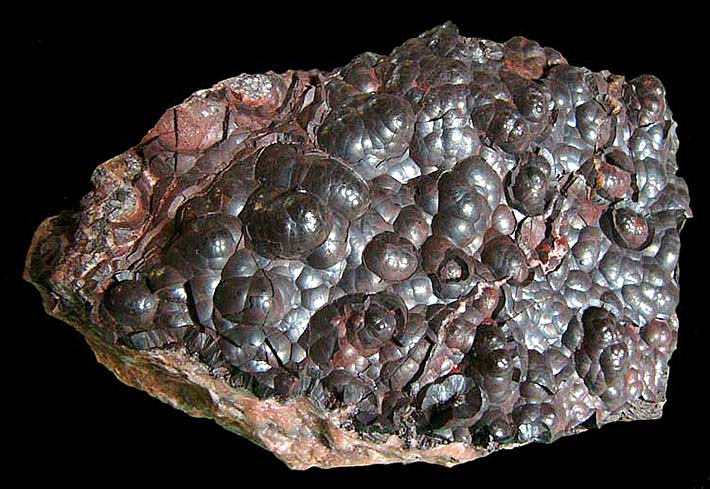
Asia
Jinlong Hill and Lechang mine, Guangdong, China produces great specimens of uncommon Iron Roses with quartz. Great hematite specimens came from Dalnegorsk and polar Ural, Russia.
Varietes of Hematite
Hematite is quite abundant and has a number of varietes:
Iron Rose (Eisenrose)
Iron Rose (in German Eisenrose) is a group of flat, pseudohexagonal hematite plates resembling a rose. This variety is typical for Alpine fissures, well developed Iron Roses are very popular and also quite expensive. Flat hematite crystals often form epitactic growths with rutile.
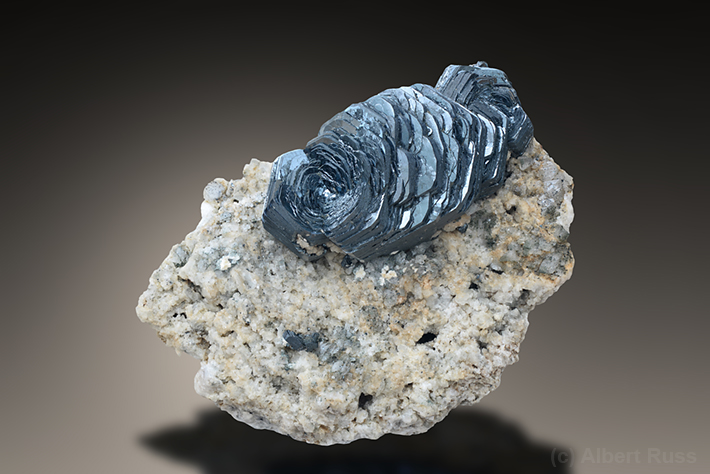
Kidney Ore
Kidney Ore includes all the massive, lumpy expressions of hematite (globular, reniform, mammilary, and botryoidal). Kidney Ore represents quite abundant and sometimes also highly aesthetic type of hematite. Shiny and well developed botryoidal aggregates are very popular among collectors.
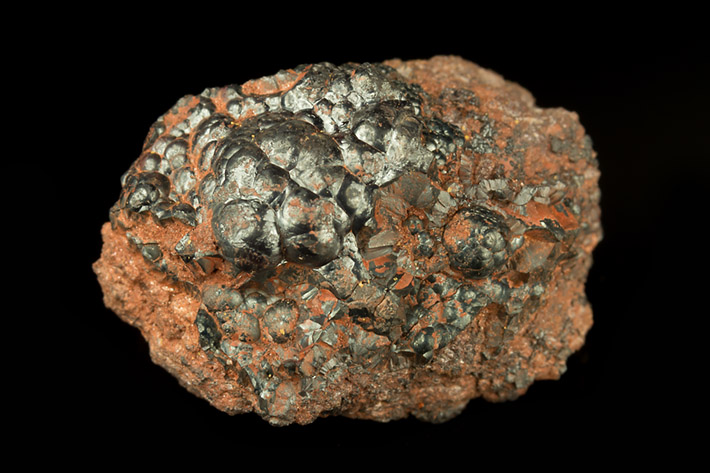
Martite
Martite is the formal name for the hematite pseudomorphs after magnetite. These pseudomorphs form in the highly oxidizing environment. Martite was first reported from Itabira, Minas Gerais, Brazil.
Iron Ochre
Iron Ochre is a hematite-rich clay, containing between 20 and 70% hematite. It occurs in two main forms:
- Red ochre is mostly composed of hematite.
- Yellow ochre is composed of mixture of hydrated iron oxides.
Strict science classifies the iron ochre as a fine grained soft rock, typically composed of hematite, goethite, lepidocrocite and other iron oxides. In strongly acidic environment, ochre contains also jarosites and schwertmannite. Red ochre (composed mostly of hematite) is typical for less acidic and dry environments.
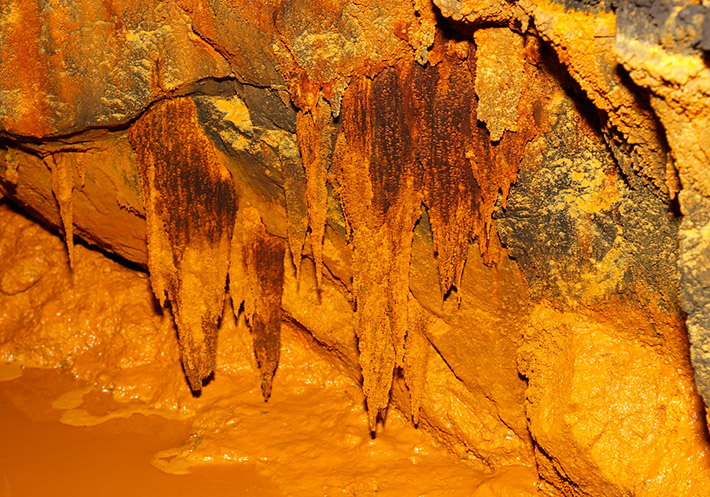
Rainbow Hematite
Rainbow Hematite is an iridescent variety of hematite. Some sources say that the play of colors is caused by a thin layer of Al-phosphate. Natural iridescent hematite should not be confused with artificially created (often tumbled) iridescent hematites, which are often not even composed of hematite!
Specularite
Specularite is a silvery, micaceous variety which is extremely common as an accessory mineral in hydrothermal uranium systems or some metasomatic deposits. It is sometimes also labeled as specular hematite or micaceous hematite.
Titano-Hematite
Titano-hematite is a titanium-rich variant, mixture of hematite and ilmenite. Based on the strict IMA classification, titanohematite is not a valid mineral. However, hematite-ilmenite solid solutions (HISS) are quite widespread in some rocks. Unlike normal hematite, titanohematite has some interesting magnetic properties. Solid solution of ilmenite and hematite exists only at high temperatures. HISS often recrystallizes into intergrowths of rutile and magnetite during cooling.





Comments